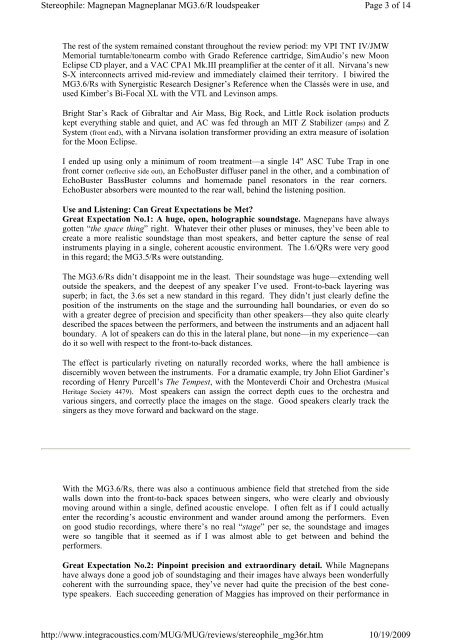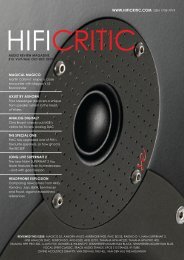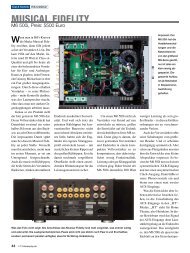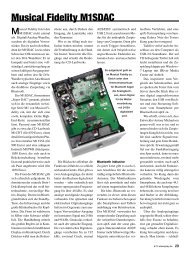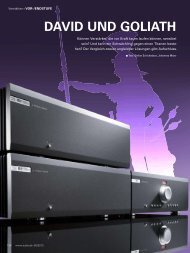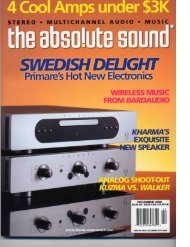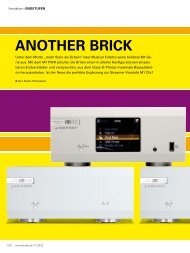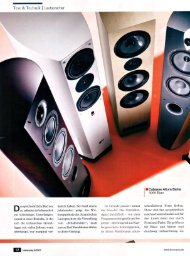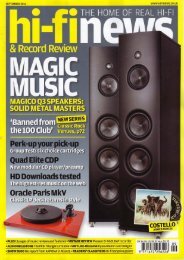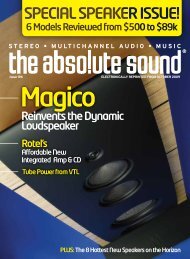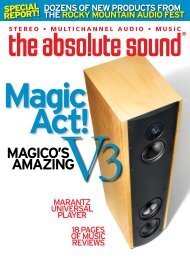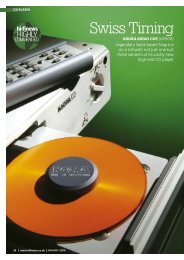MG 3.6: Magnepan's Newest Exotic Blend of Music and Magic - BM.rs
MG 3.6: Magnepan's Newest Exotic Blend of Music and Magic - BM.rs
MG 3.6: Magnepan's Newest Exotic Blend of Music and Magic - BM.rs
Create successful ePaper yourself
Turn your PDF publications into a flip-book with our unique Google optimized e-Paper software.
Stereophile: Magnepan Magneplanar <strong>MG</strong><strong>3.6</strong>/R loudspeaker<br />
Page 3 <strong>of</strong> 14<br />
The rest <strong>of</strong> the system remained constant throughout the review period: my VPI TNT IV/JMW<br />
Memorial turntable/tonearm combo with Grado Reference cartridge, SimAudio’s new Moon<br />
Eclipse CD player, <strong>and</strong> a VAC CPA1 Mk.III preamplifier at the center <strong>of</strong> it all. Nirvana’s new<br />
S-X interconnects arrived mid-review <strong>and</strong> immediately claimed their territory. I biwired the<br />
<strong>MG</strong><strong>3.6</strong>/Rs with Synergistic Research Designer’s Reference when the Classés were in use, <strong>and</strong><br />
used Kimber’s Bi-Focal XL with the VTL <strong>and</strong> Levinson amps.<br />
Bright Star’s Rack <strong>of</strong> Gibraltar <strong>and</strong> Air Mass, Big Rock, <strong>and</strong> Little Rock isolation products<br />
kept everything stable <strong>and</strong> quiet, <strong>and</strong> AC was fed through an MIT Z Stabilizer (amps) <strong>and</strong> Z<br />
System (front end), with a Nirvana isolation transformer providing an extra measure <strong>of</strong> isolation<br />
for the Moon Eclipse.<br />
I ended up using only a minimum <strong>of</strong> room treatment—a single 14" ASC Tube Trap in one<br />
front corner (reflective side out), an EchoBuster diffuser panel in the other, <strong>and</strong> a combination <strong>of</strong><br />
EchoBuster BassBuster columns <strong>and</strong> homemade panel resonato<strong>rs</strong> in the rear corne<strong>rs</strong>.<br />
EchoBuster absorbe<strong>rs</strong> were mounted to the rear wall, behind the listening position.<br />
Use <strong>and</strong> Listening: Can Great Expectations be Met?<br />
Great Expectation No.1: A huge, open, holographic soundstage. Magnepans have always<br />
gotten “the space thing” right. Whatever their other pluses or minuses, they’ve been able to<br />
create a more realistic soundstage than most speake<strong>rs</strong>, <strong>and</strong> better capture the sense <strong>of</strong> real<br />
instruments playing in a single, coherent acoustic environment. The 1.6/QRs were very good<br />
in this regard; the <strong>MG</strong>3.5/Rs were outst<strong>and</strong>ing.<br />
The <strong>MG</strong><strong>3.6</strong>/Rs didn’t disappoint me in the least. Their soundstage was huge—extending well<br />
outside the speake<strong>rs</strong>, <strong>and</strong> the deepest <strong>of</strong> any speaker I’ve used. Front-to-back layering was<br />
superb; in fact, the <strong>3.6</strong>s set a new st<strong>and</strong>ard in this regard. They didn’t just clearly define the<br />
position <strong>of</strong> the instruments on the stage <strong>and</strong> the surrounding hall boundaries, or even do so<br />
with a greater degree <strong>of</strong> precision <strong>and</strong> specificity than other speake<strong>rs</strong>—they also quite clearly<br />
described the spaces between the performe<strong>rs</strong>, <strong>and</strong> between the instruments <strong>and</strong> an adjacent hall<br />
boundary. A lot <strong>of</strong> speake<strong>rs</strong> can do this in the lateral plane, but none—in my experience—can<br />
do it so well with respect to the front-to-back distances.<br />
The effect is particularly riveting on naturally recorded works, where the hall ambience is<br />
discernibly woven between the instruments. For a dramatic example, try John Eliot Gardiner’s<br />
recording <strong>of</strong> Henry Purcell’s The Tempest, with the Monteverdi Choir <strong>and</strong> Orchestra (<strong>Music</strong>al<br />
Heritage Society 4479). Most speake<strong>rs</strong> can assign the correct depth cues to the orchestra <strong>and</strong><br />
various singe<strong>rs</strong>, <strong>and</strong> correctly place the images on the stage. Good speake<strong>rs</strong> clearly track the<br />
singe<strong>rs</strong> as they move forward <strong>and</strong> backward on the stage.<br />
With the <strong>MG</strong><strong>3.6</strong>/Rs, there was also a continuous ambience field that stretched from the side<br />
walls down into the front-to-back spaces between singe<strong>rs</strong>, who were clearly <strong>and</strong> obviously<br />
moving around within a single, defined acoustic envelope. I <strong>of</strong>ten felt as if I could actually<br />
enter the recording’s acoustic environment <strong>and</strong> w<strong>and</strong>er around among the performe<strong>rs</strong>. Even<br />
on good studio recordings, where there’s no real “stage” per se, the soundstage <strong>and</strong> images<br />
were so tangible that it seemed as if I was almost able to get between <strong>and</strong> behind the<br />
performe<strong>rs</strong>.<br />
Great Expectation No.2: Pinpoint precision <strong>and</strong> extraordinary detail. While Magnepans<br />
have always done a good job <strong>of</strong> soundstaging <strong>and</strong> their images have always been wonderfully<br />
coherent with the surrounding space, they’ve never had quite the precision <strong>of</strong> the best conetype<br />
speake<strong>rs</strong>. Each succeeding generation <strong>of</strong> Maggies has improved on their performance in<br />
http://www.integracoustics.com/MUG/MUG/reviews/stereophile_mg36r.htm<br />
10/19/2009


